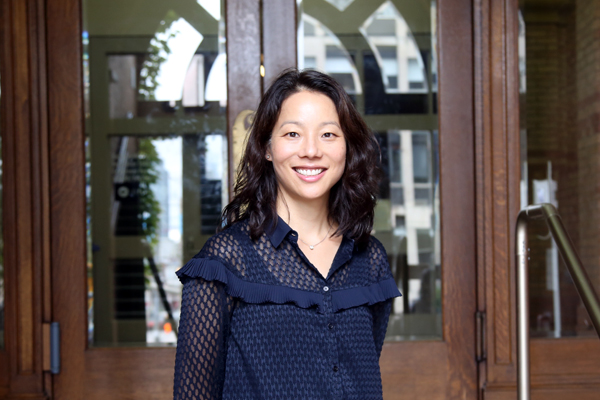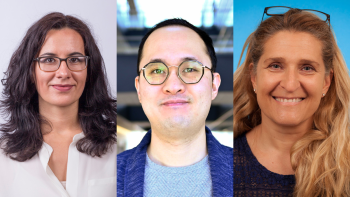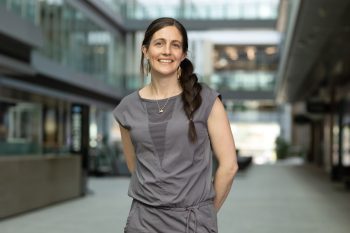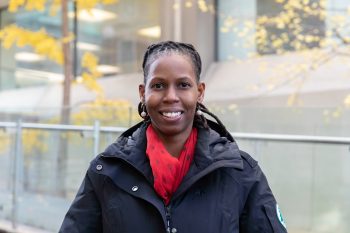Professor Naomi Matsuura (MSE, IBBME), an expert in novel materials for improved medical imaging and treatments, joined the Faculty of Applied Science & Engineering in July 2016. Her highly collaborative research bridges both engineering and medicine, and she is joint-appointed between the Department of Materials Science & Engineering, the Institute of Biomaterials & Biomedical Engineering and cross-appointed to the Department of Medical Imaging in the Faculty of Medicine.
Matsuura’s research focuses on the development of materials that can aid in both the imaging and treatment of cancers. These engineered materials can be injected into the body and remotely tracked by medical imaging technologies, such as ultrasound imaging, computer tomography and positron emission tomography (PET) scans, so as to illuminate cancerous tissues. In addition to making it easier to characterize tumours in medical scans, these materials can also be used to deliver therapies to targeted sites within the body, including to tumors in organs that are difficult to access, such as the brain.
She was recognized for her leading nanotechnology work in 2007, when she was awarded the prestigious John Charles Polanyi Prize, funded by the Ontario government and administered by the Council of Ontario Universities.
Engineering Strategic Communications sat down with Matsuura to learn more about her research, teaching and hopes for the future.
Why did you choose U of T Engineering?
U of T Engineering is a world-renowned Faculty, with incredible facilities and resources, as part of a top university. My research area is highly interdisciplinary, so being in physical proximity to so many collaborators from other departments, faculties and hospitals is a bonus. Toronto attracts extraordinarily diverse and talented students, which I believe challenges us all to become more innovative and accomplished researchers. I feel very fortunate to work here.
Tell us about your research. What kind of challenges do you address?
Through the design of novel agents, my research spans state-of-the-art materials engineering and medical science. Our goal is to use the new, targeted imaging and therapeutic compounds we develop in the lab to enable more precise diagnosis and improved local treatment of disease.
One interesting thing about these materials is that they can be activated when medical radiation triggers a change in their properties. Initially inert, these substances are transformed into active compounds that are capable of treating specific diseases within a well-defined anatomical region. Some of the challenges we address include how to make these new materials effective therapeutic agents that can subsequently clear from the patient with minimal damage to healthy tissues.
What techniques, tools or approaches do you use to address these challenges?
My group employs a variety of advanced and highly specialized techniques. One approach is to combine known materials, already used in patients, in unique ways to exploit and modify their physical and biological behaviour. We build on the fact that many medical imaging materials demonstrate strong size-dependent physical phenomena, especially at the nanoscale, which we use to create new hierarchical materials for medical applications.
In my lab, we are very multidisciplinary. My students, post-docs and research assistants have projects that span the full range of medical agent development. We first start with synthesizing new agents, followed by parameterizing their physical properties to optimize their interaction with medical radiation. Finally, we apply these agents to our targeted living systems. Our process is interactive and iterative. Through teamwork and collaboration we hope to expand the frontiers of material sciences and medicine.
What is one thing you’ve learned during your own education that you’d like to impart to U of T Engineering students?
My greatest lesson was the need for resilience. Education is not just about learning or mentorship or networking. It is also about developing the mental, emotional and physical fortitude to keep going. Our passion for life sustains us — family and friends often enable and support us — while our communities and the world-at-large provide the inspiration.
School is not the time to ignore the people important to you — it is a challenge to strengthen established relationships and form new bonds. There is no need to suspend all of your outside interests, or totally postpone “living” in the larger context. Maintain the activities that are important to you and broaden your experiences by trying new things.
My best advice: be positive, believe in yourself, work hard and always try to do your best. Ultimately, I think learning to balance and sustain your studies and your outside interests is the best path toward lifelong learning, personal satisfaction and career success.
What are you most looking forward to in your new position?
I am thrilled to join to U of T Engineering and I hope to help energize and inspire those around me. It is truly an honour to collaborate with such accomplished faculty members and to mentor such wonderful students. I am sure that together we can come up with some wild and amazing ideas to better treat cancers and improve prognoses and outcomes for patients.



